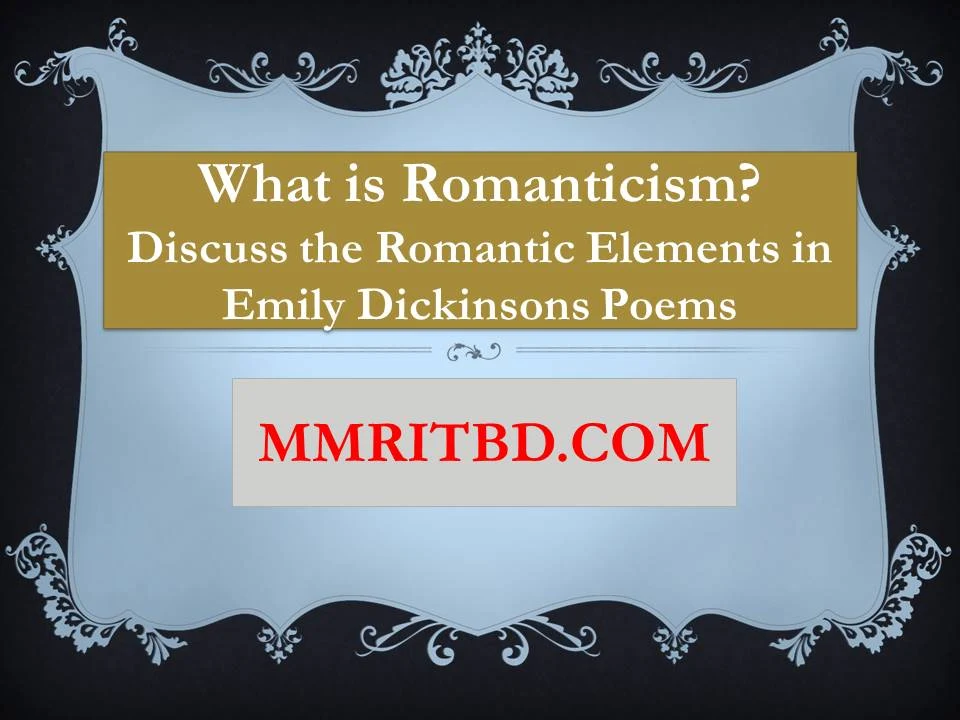What is Romanticism? Discuss the Romantic Elements in Emily Dickinsons Poems - How far is Emily Dickinson a romantic poet? Elucidate with reference to her poems.

What romantic elements do you find in E. Dickinson? Or, What Ideas of Dickinson as a romantic poet do you gather from the poems you have read? Or, What do you understand by Romanticism? What is your impression about the romanticism in Emily Dickinson? Or, How far is Emily Dickinson a romantic poet? Elucidate with reference to her poems.
Answer. The term "Romanticism" refers to a movement in art and literature which became evident in England during the later part of the 18th century, and was formally declared in 1798 in the "Preface to Lyrical Ballads" composed by Wordsworth and Coleridge. It was a revolt against the neo-classicism of the previous centuries. It is difficult to define this most meaningful and most confusing term.
However, Schlegel's definition is worth quoting. He defined it as "literature depicting emotional matter in an imaginative form." Victor Hugo defined it as "liberalism in literature". It transpires, from their definitions, that imagination, emotion and freedom are the most important aspects of Romanticism.
Romantic elements are quite obvious in Dickinson, but it should be noted that her romanticism does not fully correspond to the romantic ideas of the great English Romantic poets like Wordsworth, Coleridge, Byron, Shelley, and Keats. Of course she has incidental similarities with them in some of her ideas.
Dickinson was endowed with an excellent romantic sensibility Many of her themes and modes of writing betoken her romantic sensibility. She has displayed in her poems the freshness of imagination like that of the English romantics, and indulged in free flights of fancy like them. Her exaggerated emotionalism and her mode of writing in Romantic idiom are illustrated in many of her poems.
Her themes of Nature and childhood are strikingly closer to those of the English Romantics. Pleasures of going to Nature are a common theme of Romantic poetry. Dickinson celebrates the same ecstasy of watching the meadows, groves, hills, and the innocence of childhood. Her poem "By Sea" illustrates her romantic sensibility, and her essential romantic attitudes to Nature and childhood,
"I taste a Liquor never brewed" is a different kind of a romantic poem.
Till seraphs swing their snowy hats-
And saints to windows run
To see the little Tippler
Leaning against the sun.
This stanza from the poem represents one of her perfect romantic sensibilities in expression, and a culmination of her symbolic bacchanalia. These lines are reminiscent of the following lines of Keats's Ode to a Nightingale:
Away! away! for I will fly to thee,
Not charioted by Bacchus and his pards.
But on the viewless wings of poesy
But there is a difference between what Keats wants and what Dickinson wants Keats rejects wine as the medium of flying to the world of the Nightingale, but Dickinson wants a wine that is not available on earth Moreover, Keats' wine is a real one, and Dickinson's is symbolic. Keats wants to come back to the world, but Dickinson does not.
In another poem Dickinson celebrates the mysterious and yet glorious processes of Nature.
Nature" is what we see
The Hill-the afternoon
Thunder the Cricket-
Nay-Nature is harmony.
Dickinson's romantic sensibility is not, however, pure and unmixed. It is the Romanticism of a poet with a Calvinistic bent of mend Her Romanticism is akin to that of the English Romantics in some respects, though different in some others. She is a romantic in her own way.

